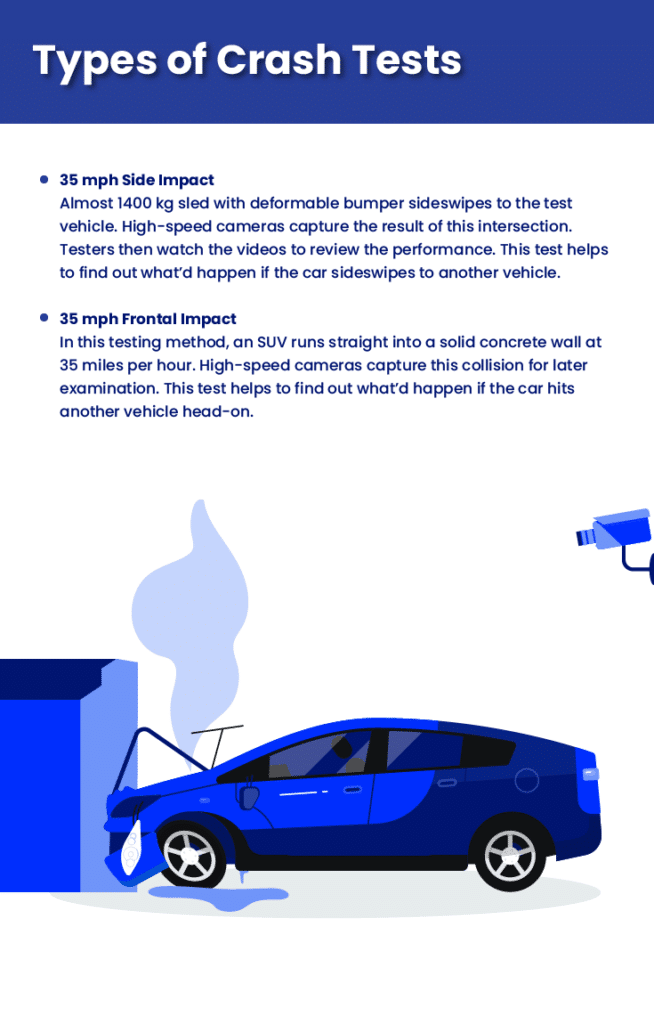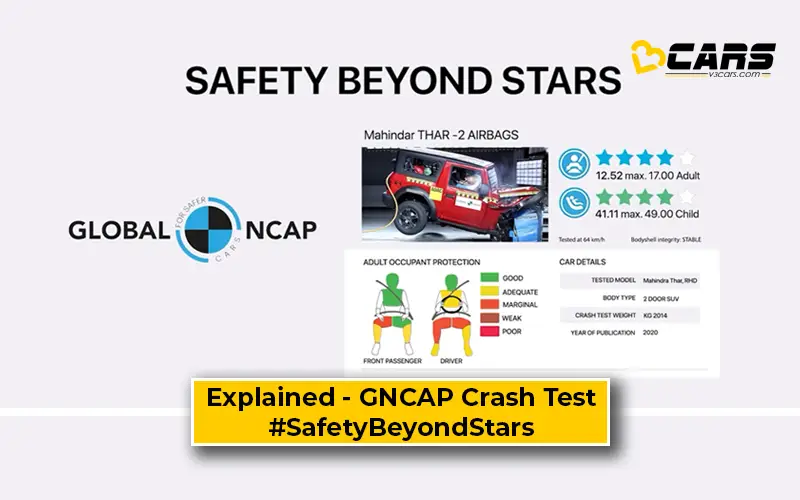Intro-
Welcome to the world of crash test ratings explained! Buckle up as we dive into the fascinating world of vehicle safety.
If you’ve ever wondered how car manufacturers evaluate the safety of their vehicles, you’re in the right place. We’re going to demystify crash test ratings and show you why they matter.
From high-speed collisions to side impacts, ratings help us understand how well a vehicle can protect its occupants in different scenarios. So, get ready to unlock the secrets. Become a savvy consumer when it comes to vehicle safety. Let’s get started!
Curious about crash test ratings?
Learn how crash test ratings work and what they mean for your safety. Understanding this is vital when choosing a car. Here’s a simple guide to help you decode the ratings:
- Research the Different Crash Test Programs
- Know the Rating Scale
- Focus on Overall Safety Ratings
- Consider Individual Crash Tests
- Look for Additional Safety Features
By following these steps, you’ll be well-equipped to interpret test ratings and make informed decisions to prioritize your safety on the road.

Source: armormax.com
Crash Test Ratings Explained: Understanding Vehicle Safety
When it comes to buying a new car, safety is a top priority for most people. Understanding test ratings helps you to make informed decisions for the safety of your loved ones. In this article, we will delve into the details of crash test ratings- explaining what they mean and how they are determined. By the end, you will have a thorough understanding of these ratings and feel confident in choosing a safe and reliable vehicle.
The Importance
Crash test ratings are crucial pieces of information that provide valuable insight into a vehicle’s safety performance. These ratings are determined through rigorous testing. The tests are conducted by independent agencies, such as the National Highway Traffic Safety Administration (NHTSA) and the Insurance Institute for Highway Safety (IIHS). By subjecting these organizations evaluate their ability to protect occupants in various collision scenarios, including front, side, and rollover crashes.
Car manufacturers are constantly working to improve vehicle safety, and ratings serve as benchmarks for this progress. By understanding and considering these ratings, you can ensure that you are selecting a vehicle that has undergone thorough testing and meets stringent safety standards. It’s important to note that higher crash test ratings do not necessarily guarantee complete protection in all situations. But they do offer a reliable indication of a vehicle’s safety performance.
Understanding the Crash Test Ratings Scale
Crash test ratings are typically presented on a scale of one to five stars, with five stars indicating the highest level of safety. The testing criteria and performance required to achieve each rating may vary slightly between organizations. So, it’s crucial to look at multiple sources and consider the specific tests conducted. Let’s delve deeper into the different ratings and what they mean:
- Five-Star Rating: A five-star test rating represents the highest level of safety. It indicates that a vehicle performed exceptionally well in various crash test scenarios. These vehicles are equipped with advanced safety features. They provide excellent protection for occupants in the event of a crash.
- Four-Star Rating: A four-star crash test rating signifies that a vehicle provides above-average safety in most crash scenarios. While it falls slightly short of the highest rating, a four-star rating still indicates solid protection for occupants.
- Three-Star Rating: A three-star crash test rating suggests that a vehicle offers average protection in crash situations. While it meets basic safety requirements, choosing a vehicle with a higher rating is recommended for enhanced safety.
- Two-Star Rating: A two-star crash test rating indicates below-average safety performance. Vehicles with this rating may have limited safety features or demonstrate inadequate protection for occupants in certain crash scenarios.
- One-Star Rating: A one-star crash test rating represents the lowest level of safety, highlighting significant shortcomings in a vehicle’s crash performance. It is essential to avoid choosing vehicles with this rating.
The Role ofTest Ratings in Vehicle Selection
When shopping for a new car, it’s crucial to consider crash test ratings as a key factor in your decision-making process. These ratings provide objective and standardized information about a vehicle’s safety performance. This allows you to compare different models and make an informed choice. Here are a few reasons why ratings should play a significant role in your vehicle selection:
- Occupant Protection: These give you an understanding of how well a vehicle is designed to protect occupants in different crash scenarios. Choosing a vehicle with a higher crash test rating can significantly reduce the risk of severe injuries.
- Collision Avoidance Technologies: Many ratings also take into account a vehicle’s collision avoidance technologies, such as automatic emergency braking and lane-keeping assist. These features can help prevent collisions or mitigate their severity.
- Insurance Premiums: Some insurance companies consider crash test ratings when determining premiums. Vehicles with higher crash test ratings may be eligible for lower insurance rates due to their enhanced safety performance.
- Peace of Mind: By choosing a vehicle with a high crash test rating, you can drive with greater confidence, knowing that you have taken important steps to protect yourself and your passengers.
The Future of Crash Test Ratings
As technology continues to advance, crash test ratings are evolving to keep pace with the ever-changing automotive landscape. New tests and assessment protocols are being introduced to evaluate emerging technologies and their impact on vehicle safety. For instance, with the rise of electric vehicles and autonomous driving features, crash test agencies are adapting their testing procedures. This is to account for the unique characteristics and challenges posed by these new technologies.
Additionally, crash test ratings are starting to consider factors beyond the structural integrity of vehicles. The integration of advanced driver assistance systems (ADAS) and crash avoidance technologies is becoming increasingly important for safety. As these technologies become more prevalent, crash test ratings will likely evolve. The rating might encompass a more comprehensive assessment of a vehicle’s safety performance.
In Summary
Crash test ratings provide essential information about a vehicle’s safety performance. This can significantly influence your decision when purchasing a new car. By understanding the different crash test ratings and their significance, you can make an informed choice. Prioritize the safety of yourself and your passengers. Remember to consider crash test ratings as one part of your decision-making process. There are other factors such as budget, lifestyle, and personal preferences. With this knowledge, you can confidently choose a vehicle that offers optimal protection and peace of mind on the road.
Key Takeaways:
- Crash test ratings help determine how safe a vehicle is in different types of crashes.
- These ratings are given by organizations such as the National Highway Traffic Safety Administration (NHTSA) and the Insurance Institute for Highway Safety (IIHS).
- They include measures like frontal impact, side impact, and rollover protection.
- A higher crash test rating indicates better protection for occupants in a crash.
- Consumers should consider vehicles with high crash test ratings when choosing a new car.
Frequently Asked Questions
Welcome to our FAQ section on crash test ratings explained. Here, we’ll answer some common questions related to understanding what they mean for vehicle safety. Read on to learn more!
1. How are crash test ratings determined?
Crash test ratings are determined through rigorous testing conducted by organizations like the National Highway Traffic Safety Administration (NHTSA) and the Insurance Institute for Highway Safety (IIHS). These tests simulate various types of collisions, to evaluate how well a vehicle protects its occupants. Based on the results, the organizations assign ratings to indicate the level of safety a vehicle offers.
The ratings typically range from one to five stars, with five being the highest level of safety. The tests assess factors like crashworthiness (how well a vehicle’s structure withstands a crash), occupant protection (the effectiveness of safety features), and crash avoidance and mitigation (the presence of technologies that can help prevent accidents or lessen their severity).
2. Are crash test ratings the same globally?
No, they can vary from one country to another. Different governments and organizations around the world have their own testing protocols, standards, and rating systems. While all these tests aim to evaluate vehicle safety, the specific criteria and rating scales used may differ. For example, crash test programs in Europe may assign different ratings compared to those in the United States.
It’s important to consider the rating system specific to your country when interpreting crash test ratings. Familiarize yourself with the testing organization and methodology to understand the level of safety a vehicle offers in your region.
3. Can a 5-star rated vehicle still be unsafe?
While a 5-star rating indicates that a vehicle offers a high level of safety, it’s essential to remember that no vehicle is entirely immune to accidents or injuries. Crash test ratings provide valuable information about a vehicle’s safety performance, but they don’t guarantee absolute safety in all situations.
Factors such as driver behavior, road conditions, and unforeseen circumstances can impact the outcome of an accident. Additionally, crash tests evaluate a vehicle’s performance under specific conditions and scenarios, so real-world situations may differ. It’s crucial to follow safe driving practices, wear seat belts, and utilize additional safety features to maximize protection in any vehicle, regardless of its crash test rating.
4. Can older vehicles have good ratings?
While newer vehicles often incorporate the latest safety features and technologies, it’s still possible for older vehicles to have good crash test ratings. Crash testing has evolved over the years, and older vehicles may have been rated using different standards and criteria.
It’s essential to consider the manufacturing year and the specific standards that were applied when assessing the old cars. Additionally, different vehicles may excel in different areas of safety. So, it’s crucial to review the specific crash test results and understand how they apply to the protection of occupants.
5. Do the ratings consider the safety of pedestrians?
Yes, crash test ratings nowadays also consider the safety of pedestrians. In recent years, organizations like the IIHS have started incorporating pedestrian crash tests. This is to evaluate vehicle designs and technologies that can mitigate injuries to pedestrians in the event of a collision.
These tests assess factors such as the vehicle’s impact-absorbing structures, energy-absorbing bumpers, and the presence of active safety features, like automatic emergency braking. By including pedestrian safety evaluations in crash test ratings, manufacturers are encouraged to enhance vehicle designs. This prioritizes not only the well-being of occupants but also pedestrians sharing the road.

Source: v3cars.com
Summary
Car crash tests tell us how safe a car is in different types of accidents. The tests evaluate things like seat belts, airbags, and the car’s structure to see how well they protect you in a crash.
Cars are given ratings from one to five stars, with five stars being the safest. When buying a car, choose one with a high rating to maximize your safety on the road. Remember, the higher the rating, the better the car performs in protecting you in an accident. So, always keep the ratings in mind when looking for a new ride and stay safe!
